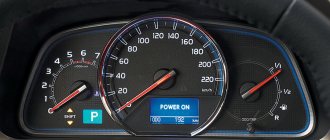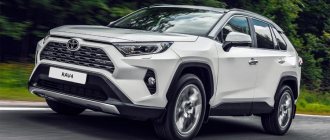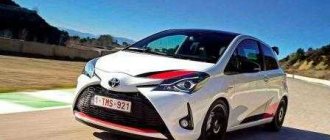Toyota Rav 4 2019 is the fifth generation of one of the most popular crossovers in the world. Previous versions of this car were also in demand among responsible buyers, so the manufacturer plans to start selling it in the summer of 2021. The reasons for purchasing it may be noticeable updates to the design and interior, a new model of the power unit and a slightly increased price.
Appearance and dimensions of Toyota RAV 4 2021
The model received an expressive design consistent with the FT-AC concept, which was presented by Toyota in 2021. The production version is practically no different from the prototype, having received a large radiator grille, narrow headlights and many horizontal lines. All this makes the crossover’s exterior more modern and original.
One of the differences between the model is the ability to choose different colors for the body and roof in order to give the car an even more unique look. And on the top of the racks there is a special thin line. With its help, the roof level visually changes depending on the chosen color schemes.
The dimensions of the crossover are made optimal for urban conditions:
- the width, increased by 10 mm compared to the previous generation, is 1.854 m;
- length is 4.595 m (5 mm more);
- the height decreased by 5 mm - to 1.699 m.
The maximum crossover wheel size is 19 inches instead of the 18-inch wheels of previous generations. Shortened overhangs and increased approach and departure angles have improved the vehicle's off-road performance. Now its ground clearance is not 20, but 21 cm, which allows you to freely drive on bad roads and off-road.
Salon
The interior of the new Toyota Rav 4 2021 model has changed as noticeably as the appearance. And, although the interior has not become as futuristic as some models from other manufacturers (for example, Volkswagen Touareg), it looks quite modern:
- above the center console there is a touch display of the Entune 3.0 multimedia system with a diagonal of 7 or 8 inches (depending on the configuration);
- the panel contains buttons that allow you to control the audio system, change the climate and driving modes;
- The finishing materials have noticeably improved, although they are not premium – however, these indicators are sufficient for middle-class crossovers.
The crossover seats have lateral support. And there is enough space in the second row for three adult passengers. Although during a test drive, some experts concluded that the knees of people sitting in the rear seats may rest against the backrests located in front.
Toyota launched production of the new RAV4 for the Russian Federation and revealed its prices
Serial production of the new generation RAV4 SUV started today at the Toyota St. Petersburg plant. This model was presented back in the spring of 2021 at the New York Auto Show. Now the cross is already sold in many markets, and now it has reached Russia. The company published prices: during the change of generations, one of the brand’s bestsellers in the Russian Federation, as expected, noticeably increased in price.
The fifth generation crossover is based on the GA-K platform of the TNGA architecture (its predecessor had the New MC). The distance between the axles has increased by 30 mm (now equal to 2,690 mm). At the same time, the new SUV is 5 mm shorter than the previous RAV4 (length – 4,600 mm). The exterior has been designed to match the brand’s large SUVs: the front part looks more aggressive due to the new wide radiator grille, and the profile due to the angular wheel arches. In the cabin, a screen of the Entune 3.0 multimedia system with support for Apple CarPlay and AndroidAuto appeared protruding beyond the front panel.
The fifth generation Toyota RAV4 in Russia is available with new four-cylinder naturally aspirated petrol engines of the Dynamic Force family with combined fuel injection and a VVT-iE gas distribution system on the intake valves. Their volume is 2.0 and 2.5 liters, output is 149 and 199 hp. respectively (206 and 243 Nm). The first engine is equipped with a six-speed manual or CVT, the second with an eight-speed automatic. The company has so far indicated dynamic performance only for cars with a two-liter engine. The maximum speed is 190 km/h, from zero to “hundreds” the version with a manual transmission accelerates in 9.8 seconds, with a CVT in 11 seconds.
The cross has two all-wheel drive options. The first is Dynamic Torque Control AWD - with a rear axle coupling (usually the torque between the front and rear wheels is distributed in a ratio of 100:0, but depending on driving conditions, the electronics can redistribute traction up to a ratio of 50:50). The second scheme – Dynamic Torque Vectoring AWD – involves two separate drive couplings on each of the rear wheels.
The initial version is offered with LED optics, air conditioning, the ability to select driving modes, 17-inch alloy wheels, an extended “winter” package, seven airbags, a new anti-theft system, etc. Such a car will cost at least 1,756,000 rubles. The basic equipment of the fourth RAV4 in the Russian Federation now costs 1,616,000 rubles (that is, the increase was 140 thousand rubles).
The top version has a leather interior, an electrically adjustable driver's seat, parking sensors, wireless charging for a smartphone, heated rear seats, 19-inch wheels, all-round cameras, adaptive cruise control, etc. The price of this version of the new Rafik is 2,661,000 rubles, and its predecessor – 2,348,000 rubles (313 thousand rubles more).
Now the most popular version in the Russian Federation is the RAV4 version with all-wheel drive, a two-liter engine, which is paired with a CVT. For the fifth generation model, its cost starts at 2,087,000 rubles. Competitors currently have more attractive price tags. Thus, a Mitsubishi Outlander in a similar version can be purchased for 1,894,000 rubles, and a Nissan X-Trail with similar technical characteristics can be purchased for 1,800,000 rubles.
By the way, all three models have high sales figures in Russia in 2019. Thus, in January-August, Toyota RAV4 sold 19,597 units, Mitsubishi Outlander – 14,702 units, and Nissan X-Trail – 13,244 units.
Technical characteristics of Toyota Rav 4 2021
The manufacturer is going to release a crossover with:
- 2-liter gasoline engine with 146 hp. and fuel consumption of 7.7 liters per 100 km;
- hybrid power plant with a volume of 2.5 liters and a performance of 200 hp.
The first two engines will be equipped with a 6-speed manual transmission. A CVT is additionally available for the petrol version, and a 6-speed automatic transmission is available for the diesel engine. The “hybrid” engine will most likely be paired with an 8-speed automatic transmission. Among the basic configurations you will find versions with front-wheel drive, while the top ones will only have all-wheel drive (with 50% of the torque transmitted to the rear axle).
The dynamic characteristics of the Toyota Rav 4 2021 depend on the specific modification. For models equipped with a 2-liter engine and a manual transmission, the acceleration time to 100 km/h will be 10.1 seconds, with a CVT – 11.0 seconds, and all-wheel drive – 11.2 seconds. The maximum speed for such a motor is 180 km/h. A modification with automatic transmission, all-wheel drive and a “hybrid” power unit will accelerate the car to “hundreds” in 9.3 seconds, and a powerful diesel engine will do this in 9.9 seconds.
Among the changes to the car, it is worth paying attention to the increased trunk volume. Now, with the rear seats in the normal position, the luggage compartment holds 547 liters. If the seats are folded, the capacity increases to 1650 liters. Additional functionality for the trunk when placing cargo is provided by fastening nets.
The safety of the driver and passengers is ensured by a huge list of special options that the car has received. These include a system that prevents collisions with pedestrians, dynamic cruise control, automatic high beams, lane tracking and even reading road signs. The high level of safety is confirmed by passing the NCAP crash test. In it, the RAV4 received 5 stars out of 5 possible.
Full technical specifications of Toyota RAV 4 (XA50 body)
| Parameter | Toyota RAV4 2.0 149 hp | Toyota RAV4 2.5 199 hp | ||
| Engine | ||||
| Engine code | M20A-FKS | A25A-FKS | ||
| engine's type | petrol | |||
| Injection type | combined | |||
| Turbocharging | No | |||
| Cylinder configuration | R4 | |||
| Volume, cubic cm. | 1987 | 2487 | ||
| Cylinder diameter/piston stroke, mm | 80.5 x 97.6 | 87.5 x 103.5 | ||
| Power, hp (at rpm) | 149 (6600) | 199 (6600) | ||
| Torque, N*m (at rpm) | 206 (4400-4900) | 243 (4000-5000) | ||
| Transmission | ||||
| Drive unit | front | full | full | |
| Transmission | 6 manual transmission | CVT | CVT | 8 automatic transmission |
| Suspension | ||||
| Front suspension type | independent MacPherson type | |||
| Rear suspension type | independent multi-link | |||
| Brake system | ||||
| Front brakes | ventilated disc | |||
| Rear brakes | disk | |||
| Steering | ||||
| Amplifier type | electric | |||
| Tires and wheels | ||||
| Tire size | 225/65 R17 / 225/60 R18 / 235/55 R19 | |||
| Disk size | n/a | |||
| Fuel | ||||
| Fuel type | AI-95 | |||
| Environmental class | Euro 5 | |||
| Tank volume, l | 55 | |||
| Fuel consumption | ||||
| Urban cycle, l/100 km | 8.6 | 7.8 | 8.2 | 9.2 |
| Extra-urban cycle, l/100 km | 6.8 | 6.5 | 6.7 | 7.2 |
| Combined cycle, l/100 km | n/a | n/a | n/a | 8.4 |
| dimensions | ||||
| Number of seats | 5 | |||
| Length, mm | 4600 | |||
| Width, mm | 1855 | |||
| Height, mm | 1685 | |||
| Wheelbase, mm | 2690 | |||
| Front wheel track, mm | 1600-1610 | |||
| Rear wheel track, mm | 1630-1640 | |||
| Front overhang, mm | 925 | |||
| Rear overhang, mm | 985 | |||
| Trunk volume (min/max), l | 580/1690 | |||
| Ground clearance (clearance), mm | 195 | 200 | ||
| Weight | ||||
| Curb (min/max), kg | 1570/1575 | 1610/1620 | 1675/1730 | 1680/1740 |
| Full (min/max), kg | 2015 | 2090 | 2120/2170 | 2125/2175 |
| Maximum trailer weight (equipped with brakes), kg | 1500 | |||
| Maximum trailer weight (not equipped with brakes), kg | 750 | |||
| Dynamic characteristics | ||||
| Maximum speed, km/h | 190 | 200 | ||
| Acceleration time to 100 km/h, s | 9.8 | 11.0 | 8.5 | |
Competitors of Toyota RAV 4 2021
The popularity of the crossover segment increases the number of possible competitors of the Rav 4. Among them, it is worth noting the following models:
- Honda CR-V (price from $30,000);
- Mazda CX-5 (about $25,000);
- Nissan Qashqai ($20-30 thousand);
- Subaru Forester (from $30,000).
Considering the expected price of the Rav 4 is about $30,000, it is quite capable of becoming a competitor to most models with similar characteristics. The only serious rival is the Qashqai, which constantly ranks first in the ranking of the most popular cars in Europe.
Options and prices for the 2021 RAV 4
Basic versions of the car are equipped with a 2-liter engine and the following equipment:
- 8 airbags;
- collision warning system;
- adaptive cruise control;
- tire pressure sensors;
- Isofix child seat mounts;
- electric parking brake;
- automatic high beam;
- a system capable of recognizing road signs.
Owners of top trim levels can count on electrically adjustable front seats, dual-zone climate control, a premium audio system with 11 speakers, and an electric tailgate with contactless opening. The interior of these versions will be leather, and one of the options is a panoramic roof with a sunroof.
The estimated cost of the car, which will appear in Russia no earlier than June 2021, ranges from 1.6 to 2.3 million rubles. The same model is expected in Ukrainian car dealerships at about the same time. The estimated cost is in the range of 0.7–1.2 million hryvnia.
Table 1. Parameters of basic configurations.
| Name | Engine | Transmission | Drive unit | Approximate price, million rubles. |
| 2.0MT | 2.0 l, 146 hp, gasoline | Mechanics | front | 1,6 |
| 2.0 CVT | variable speed drive | 1,8 | ||
| 2.0 CVT 4WD | full | 2,0 | ||
| 2.5 AT 4WD | 2.5 l, 200 hp, gasoline | machine | 2,3 | |
| 2.2 TD AT 4WD | 2.2 l, 150 hp, diesel | 2,1 |
New Toyota RAV4 2021: photo and price, crossover characteristics
The latest news suggests that the new 2021 Toyota Rav 4 model, which debuted in America, will have specifications and prices that will become known immediately after it is released in Russia. Some delay will be caused by the need to re-adjust the conveyor at the joint venture in St. Petersburg. The Russian market is one of the priorities for the Japanese, so the start of sales of the new Japanese crossover in Russia is expected in the middle of this year.
The technical characteristics of the new product will be offered: a 2-liter gasoline engine with a capacity of 149 horsepower, front-wheel drive and a 6-speed manual transmission. In total, the arsenal of the new crossover includes: 3 power units, 3 types of gearboxes, 2 types of drives and 6 basic configurations. According to the latest news, the official release date of the 2021 Toyota Rav 4 took place at the New York Auto Show on March 28 this year.
Navigation
Pros and cons of Toyota RAV4
+ Pros
- Salon
- Design
- Reliability
- Trunk
- Dynamics
- Visibility
- Salon
- Patency
- Economical
- Variable speed drive
- Liquidity
- Microclimate
- Light
- Minuses
- Build quality
- Paint quality
- Noise insulation
- Suspension
Reviews from Toyota RAV4 owners
The ride is significantly (in my opinion) different from the previous model. It has become more energy-intensive, it swallows potholes, and the rear suspension does not break through as before at every crack in the asphalt. They improved it for the better. Noise insulation remains the same as it was. I think this is not just a problem with Toyota. There is no normal noise in the car.
The headlights are LED, of course the difference is huge from conventional ones. My configuration also includes, and which was not previously available, a heated steering wheel, a heated windshield, a light sensor, a rain sensor (not needed at all, it works haphazardly), a rear view camera with dynamic lines (there are no parking sensors, you have to get used to the camera, and then I got used to the sensors after the camera), cruise control, a button for forced locking of the cross-axle differential, an additional electric interior heater (haven’t tested it yet), an electric rear door (for me this is more of a minus than a plus, as they say “from your feet” you can’t close it anymore and it works too slowly).
Eats a lot of gasoline in winter 13-15 liters per 100 km, in winter at temperatures below 15 degrees with heavy snow, the windshield at the bottom freezes with ice wipers stick, full blowing and heating of the glass on the highway does not help, you have to stop and scrape the ice (today in general on the road at full heating and blowing of the windshield, as usual, I pulled the wiper lever to brush off the melted snow, the wiper rubber came off, I had to lift it and get home without it, the visibility from behind is very poor, large blind spots, there is not enough power reserve when overtaking, you need to be very careful so as not to get caught in an accident , sound insulation is poor.
The brakes are sharper. Now the running-in is without sudden starts and high revs. But even so, the front wheels easily slip when you take off (it's -10 on the street). Therefore, if you have the opportunity to take all-wheel drive, you should take it)) I really like the interior, as well as the exterior. Although the rear seat no longer moves back and forth. However, I also used this opportunity only a couple of times. But the tilt of the back of the rear seats is now adjusted more conveniently: at the bottom on the side, like in the front ones. The driver's seat is adjustable up and down. I like to sit high. They usually write that it is inconvenient to use the buttons at the bottom of the dashboard. For me it's not a problem.
The car is comfortable, the seating position is high and comfortable, the ground clearance is sufficient for the urban jungle. The low beam illuminates the road very well, the winter package is a separate matter - the heated windshield eliminates the need for squeegee in the morning. The engine is not the most powerful - 2.0 liters, so when you sharply press the gas, it roars from effort and moves a little, but I’m not a racer and I look at things realistically. Who needs a sport - this is another car or at least 2.5 liters. Some people don’t like the seat heating keys - they say they’re like on a six Zhiguli, but for me it’s the opposite - many people started with them!
Reviews from Toyota RAV4 car owners with photos on auto.mail.ru, drom.ru, drive2.ru and auto.ru
Toyota RAV4 2021 prices and specifications
The price of Toyota RAV 4 2021 in Russia ranges from 1,616,000 to 2,348,000 rubles; the crossover is offered in Standard, Standart Plus, Comfort Plus, 25t Anniversary, Prestige and Prestige Safety trim levels.
| Equipment | price, rub. |
| 2.0 (146 hp) Standard MT6 2WD | 1 616 000 |
| 2.0 (146 hp) Standard Plus CVT 2WD | 1 703 000 |
| 2.0 (146 hp) Standard Plus CVT 4WD | 1 802 000 |
| 2.0 (146 hp) Comfort Plus CVT 2WD | 1 811 000 |
| 2.0 (146 hp) Comfort Plus MT6 4WD | 1 863 000 |
| 2.0 (146 hp) Comfort Plus CVT 4WD | 1 946 000 |
| 2.0 (146 hp) 25th Anniversary CVT 4WD | 2 006 000 |
| 2.5 (180 hp) Comfort Plus AT6 4WD | 2 077 000 |
| 2.0 (146 hp) Prestige CVT 4WD | 2 084 000 |
| 2.2D (150 hp) Comfort Plus AT6 4WD | 2 119 000 |
| 2.5 (180 hp) 25th Anniversary AT6 4WD | 2 137 000 |
| 2.0 (146 hp) Prestige Safety CVT 4WD | 2 181 000 |
| 2.5 (180 hp) Prestige AT6 4WD | 2 251 000 |
| 2.2D (150 hp) Prestige AT6 4WD | 2 293 000 |
| 2.5 (180 hp) Prestige Safety AT6 4WD | 2 348 000 |
* MT6 - six-speed manual transmission, AT6 - six-speed automatic transmission, CVT - variator, 4WD - four-wheel drive, D - diesel
Technical Specifications of Toyota RAV4
Body
| Body type | crossover |
| Car class | compact crossover |
| Length / width / height, mm | 4605 / 1845 / 1670 |
| Wheelbase, mm | 2660 |
| Ground clearance (ground clearance), mm | 2660 |
| Trunk volume, l | 577 |
| Curb weight, kg | 1540 — 1715 |
| Fuel tank volume, l | 60 |
Engine and transmission
| engine's type | petrol | petrol |
| Volume, l | 2,0 | 2,0 |
| Power, hp | 146 | 146 |
| Torque, Nm | 187 | 187 |
| Gearbox type | Mechanics | variable speed drive |
| Number of gears | 6 | — |
| Drive unit | front | front |
| Acceleration 0-100 km/h, s | 10,2 | 11,1 |
| Max speed, km/h | 180 | 180 |
| Fuel consumption, l | ||
| - city | 9,7 | 9,4 |
| - track | 6,4 | 6,3 |
| - mixed | 7,7 | 7,4 |
| Fuel type | AI-95 | AI-95 |
Engine and transmission
| engine's type | petrol | petrol |
| Volume, l | 2,0 | 2,5 |
| Power, hp | 146 | 180 |
| Torque, Nm | 187 | 233 |
| Gearbox type | variable speed drive | machine |
| Number of gears | — | 6 |
| Drive unit | full | full |
| Acceleration 0-100 km/h, s | 11,3 | 9,4 |
| Max speed, km/h | 180 | 180 |
| Fuel consumption, l | ||
| - city | 9,4 | 11,6 |
| - track | 6,4 | 6,9 |
| - mixed | 7,5 | 8,6 |
| Fuel type | AI-95 | AI-95 |
Engine and transmission
| engine's type | diesel |
| Volume, l | 2,2 |
| Power, hp | 150 |
| Torque, Nm | 340 |
| Gearbox type | machine |
| Number of gears | 6 |
| Drive unit | full |
| Acceleration 0-100 km/h, s | 10,0 |
| Max speed, km/h | 185 |
| Fuel consumption, l | |
| - city | 8,1 |
| - track | 5,9 |
| - mixed | 6,7 |
| Fuel type | diesel |
CarsGuru
Maximum power of 150 hp. The diesel engine develops at 3,600 rpm, and demonstrates a maximum torque of 340 Nm in the range from 2,000 to 2,800 rpm. The maximum speed according to the passport is 185 km/h. Acceleration to hundreds should take, according to the manufacturer's calculations, 10 seconds. Tank - 60 liters. Eco class - Euro-5. Claimed consumption is 8.1 liters in the city, 6.7 liters in mixed mode and 5.9 liters on the highway. In reality, consumption is about 8 liters on the highway, about 9.5 in mixed mode and from 12 to 13.5 in the city (depending on the intensity of traffic jams). It seemed to me that overall it was a bit much for a diesel engine.
Gasoline engines - either 2 liters for 146 hp, or 2.5 liters for 180 hp. Diesel power unit - 2.2 liters with 150 hp.
► New crossovers of 2021: photos and prices
► Chinese crossovers in Russia: what to buy
Video test drive of the new Toyota RAV4
Which car would you prefer?
Read test drives of Toyota RAV4 on Za Rulem, Kolesa.ru, CarsGuru, Drive.ru
Appearance
Behind the wheel
The RAV4 designers, it seems, have really been completely dismissed - in the sense, not to go home, but emotionally and documentarily. How else to explain the fact that the FT-AC concept shown last year turned out to be an almost exact copy of the production model? Yes, with this approach it is now unlikely that housewives will be able to fit housewives into the RAV4 - but almost all other “target groups” are unlikely to be dissatisfied. Well, the Japanese are trying to please the eyes of lovers of gloss and gloss with external decoration, which, however, is somewhat discordant with the image of the “conqueror of space.” The bright image accompanies the model’s logical transition to the new GA-K platform of the TNGA architecture: this is exactly what the RAV4 has in common with the Camry, and at the same time with the Avalon and Lexus ES. However, this does not mean absolute technical relatedness - the machines are simply scaled according to a similar principle. There is 13 centimeters less space between the axles than the Camry, but 3 centimeters more than the old RAV4 - 2,690 millimeters.
True, the geometry here is somewhat unconventional: usually manufacturers report an increase in the wheelbase in parallel with the overall length, and at the same time an increase in the reserve for passengers and luggage. Here everything is nonlinear in Japanese.
The base has become 3 centimeters larger, and the total length has become 5 millimeters smaller. The rear overhang is 30 millimeters shorter and the trunk is 79 liters larger (626 litres). The ground clearance is 15 millimeters higher, and the gap between the driver’s buttocks and the road is the same as it was: the seat has been lowered by the same 15 millimeters. Fortunately, not all the numbers are so disparate: body rigidity was increased by 57% with high-strength steels - and there is nothing to oppose this.
Salon
Drive.ru
You recognize a Toyota by its birthmarks. The steering column lacks reach adjustment slightly. Some buttons - as if straight from the 90s - are not backlit and are randomly scattered around the cabin. Only the driver's window regulator has automatic mode. At night, the bright climate control unit is annoying. But the chairs are cool, visibility with large mirrors is better, niches for small items are conveniently organized, and the materials are good. And, of course, space. People at home will like that the Rafik has the most space in the back, and they will also approve of the trunk. But everyone on the road will miss comfort. Recognizable and comfortable (with some flaws) interior. I'm tired of Toyota's economy: the RAV4 is the only one without a glove compartment light. A small complaint about visibility is related to the area at the left pillar that is not cleaned by the wiper, which is five to six centimeters wide.
Excellent chairs with good lateral support and large cushions. It’s a pity that lumbar support adjustment appears only in expensive trim levels. The second row is the most spacious in all directions. The backrest is adjustable and heated.
There are good instruments with a clear on-board computer display. Toyota still has a manual parking brake. Thanks to the winding groove, the desired selector position is unmistakably located, and in manual mode the variator perfectly simulates seven gears.
Photos of the new Toyota RAV4 2019
PreviousReviewsNew Hyundai Tucson 2021: photo and price, crossover characteristics
Next
ReviewsNew Toyota Fortuner 2021: photo and price, SUV characteristics
Expert opinions
Despite the lack of a car for sale and reviews from its owners, a definite opinion about the new generation RAV4 can be formed based on the results of test drives. Drivers who have already tested the crossover consider it a good option that can increase Toyota's sales in this segment. Good dynamics, improved quality of materials and modern safety technologies make the model a serious competitor to other middle-class crossovers. Don’t discount the Rav 4’s cross-country ability and appearance, which can become decisive arguments in its favor when choosing between several similar cars.
( 3 ratings, average: 4.67 out of 5)










